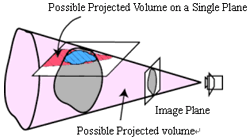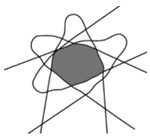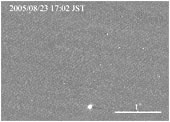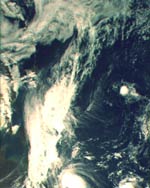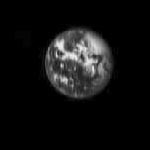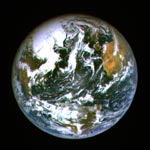Topics List
Sep. 7, 2016 Updated
Submicrometer craters in samples returned from the asteroid Itokawa
|
It is previously reported that precious few Itokawa particles show submicrometer craters on their surface. An international research team led by Dr. Dennis Harries (Friedrich Schiller University Jena) has investigated these craters in details using scanning electron microscopy and transmission electron microscopy. As a result of their observations, 15 craters were confirmed on a new particle. Though particles showing such craters had also been found in previous studies, those particles showed only 1-2 craters on their surface. Thus, the new particle found by the research team shows unusual number of craters on the surface of one particle. |
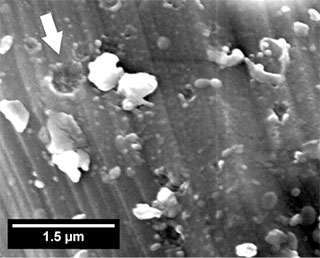
|
|---|
Jun. 22, 2016 Updated
Trace of Itokawa's Four Billion Years of History Found on Particles
|
A research team led by Aerospace Project Research Associate Toru Matsumoto of JAXA found that traces of more than four billion years of history up until now of the Asteroid "Itokawa" were recoded on the surface of particles that were recovered from Itokawa by the Asteroid Explorer “Hayabusa” to bring back to the Earth, and their surface patterns and marks were analyzed by the research team. |
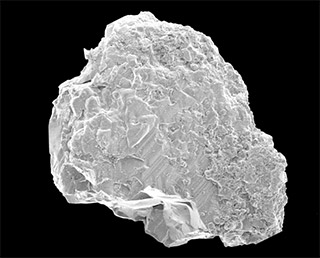
|
|---|
Jun. 26, 2013 Updated
Particles captured on asteroid Itokawa on exhibition.
|
JAXA is exhibiting particles brought back to the Earth by the asteroid explorer “Hayabusa,” which returned in June 2010, at the National Museum of Nature and Science and at the Sagamihara City Museum thanks to their cooperation. - National Museum of Nature and Science Permanent Exhibit - Sagamihara City Museum Limited-time Only Exhibit |
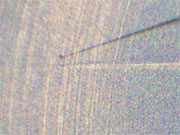
|
|---|
Jan. 9, 2013 Updated
Second International AO for Hayabusa sample investigation
|
The international AO this time aims at contributing to the further development of global asteroid science by offering samples to international researchers. Please confirm the application conditions. We are waiting for your proposals. |
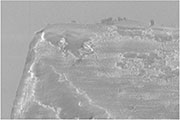 |
|---|
Jan. 24, 2012 Updated
1st International Announcement of Opportunity for HAYABUSA Sample Investigation
|
Japan Aerospace Exploration Agency (JAXA) has been engaged in initial analysis* of Itokawa’s sample brought back by HAYABUSA. On this occasion we would like to inform you of offering the announcement of opportunity for HAYABUSA Sample Investigation. |
 |
|---|
Aug. 26, 2011 Updated
American magazine "Science" features Hayabusa
|
JAXA is currently working on collecting and cataloging particles brought back by the sample return capsule aboard the asteroid explorer Hayabusa. |
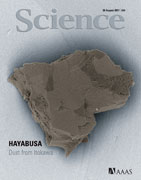 |
|---|
Jun. 13, 2011 Updated
HAYABUSA recognized by Guinness World Records
|
The Asteroid Explorer HAYABUSA, which returned to the Earth on June 13, 2010, after overcoming various difficulties during some seven years in space, marked the one-year anniversary of its homecoming. |
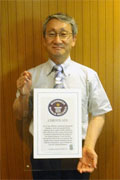 |
|---|
May 23, 2011 Updated
HAYABUSA project team recieved Wernher von Braun Memorial Award
|
On May 20th, the National Space Society presented the Wernher von Braun Memorial Award to the HAYABUSA project team at the 2011 International Space Development Conference (ISDC), held at the von Braun Center in Huntsville, Alabama. The award recognizes "the first round trip to and sample return from the surface of an object in solar orbit". |
 |
|---|
Mar. 11, 2011 Updated
Preliminary results of initial analysis of particles brought back by Hayabusa
|
Since late January 2011, JAXA has been engaging in an initial analysis of the particles in the sampler container which was brought back by the asteroid exploration spacecraft "Hayabusa,"and some of the results of the initial analysis were presented at the 42nd Lunar and Planetary Science Conference (LPSC). |
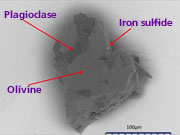 |
|---|
Nov. 16, 2010 Updated
Particles brought back by Hayabusa identified as from Itokawa
|
JAXA has been engaged in collecting and categorizing particles in the sampler container that were brought back by the asteroid explorer "HAYABUSA." |
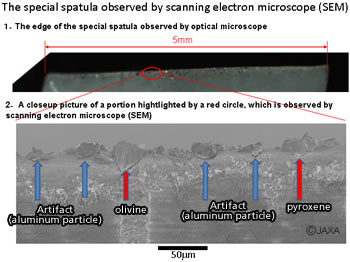 |
|---|
Oct. 8, 2010 Updated
Electron microscopic photos of particles taken from the HAYABUSA capsule
|
JAXA is currently observing particles that were collected by a Teflon spatula from a sample container (*1) of the HAYABUSA at the Curation Center (*2) at the JAXA Sagamihara Campus. As a result of direct observations of specimens taken by the spatula through the Scanning Electron Microscope, we found many particles. |
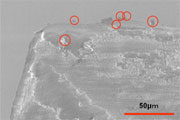 |
|---|
Aug. 19, 2010 Updated
Over 100,000 people witness the HAYABUSA capsule!
|
The total number of visitors to the Asteroid Explorer HAYABUSA’s capsule at the Sagamihara City Museum, Tsukuba Space Center, and Marunouchi OAZO reached 101,091 as we completed the exhibition in Marunouchi today. JAXA presented a commemorative gift to the 100,000th visitor, Moe Nakajima (11 years old.) |
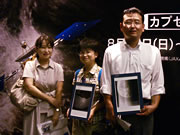 |
|---|
Jul. 8, 2010 Updated
Exhibition of the HAYABUSA capsule and other interesting things
|
This summer, we are exhibiting a part of the capsule of the Asteroid Explorer "HAYABUSA," which returned to the Earth on June 13, and other interesting things at the Sagamihara City Museum, JAXA Tsukuba Space Center, and at the OO square on the first floor of Marunouchi Oazo Building. |
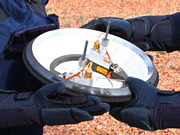 |
|---|
Jul. 5, 2010 Updated
Small particles found in the sample container of the HAYABUSA
|
Minute particles were confirmed in the sample container of the HAYABUSA, whose unpacking operation was started on June 24 (JST) at the Curation Center at the Sagamihara Campus. We are still unsure if those particles are something from the ITOKAWA or from the Earth, thus we will further examine them. (Image: opened sample container) |
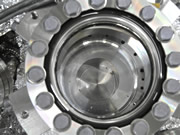 |
|---|
Jun. 24, 2010 Updated
Starting to open HAYABUSA sample container
|
A capsule of the Asteroid Explorer "HAYABUSA," which returned to Earth on June 13, was brought to the curation facility at the Sagamihara Campus to be inspected and disassembled. |
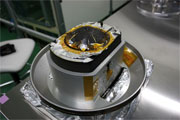 |
|---|
Jun. 14, 2010 Updated
Welcome back HAYABUSA to Earth after overcoming various difficulties!
|
The Asteroid Explorer "HAYABUSA" successfully separated its capsule at 7:51 p.m. on June 13 (Japan Standard Time, the following times and dates are all JST,) and re-entered the atmosphere to complete its mission operation at 10:51 p.m. |
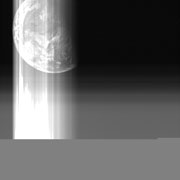 |
|---|
Jun. 5, 2010 Updated
HAYABUSA heading to Australia
|
JAXA confirmed that the third trajectory correction maneuver (TCM-3) was successfully carried out for the Asteroid Explorer "HAYABUSA" at 1:44 p.m. on June 5 (Japan Standard Time.) This operation completed the guidance of the HAYABUSA from the Earth's outer rim to the Woomera Prohibited Area in South Australia. 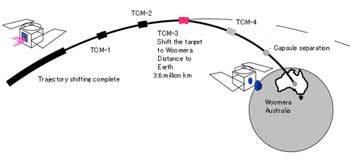
|
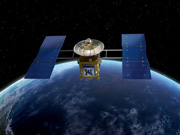 |
|---|
Apr. 21, 2010 Updated
HAYABUSA's Sample Recovery Capsule to land on Earth on June 13
|
JAXA has been discussing with the Australian government the landing location for the Sample Recovery Capsule aboard the Asteroid Explorer "HAYABUSA," which is being carefully maneuvered for its return. As a result, we have received landing permission (the Authorized Return of Overseas Launch Space Object (AROLSO) from the Space Licensing and Safety Office (SLASO) of the Australian Government. 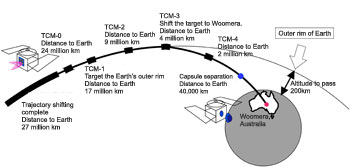
|
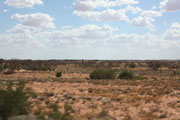 |
|---|
Mar. 1, 2010 Updated
HAYABUSA enters an orbit inside the Moon's orbit
|
HAYABUSA, which is traveling back to the Earth, is confirmed to have taken an orbit that runs inside of the Moon's orbit. The perigee of the current orbit is about 310,000 km from the Earth. In early March, we will temporarily stop the ion engine to estimate its precise orbit. |
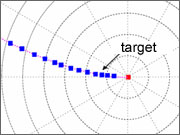 |
|---|
Jan. 14, 2010 Updated
HAYABUSA coming back to terrestrial gravitation realm! Soon to be home
|
The Asteroid Explorer "HAYABUSA," which is on its way back to the Earth,has gradually been changing its orbit to come closer to the Earth. The explorer is now confirmed to be on an orbit that passes through the inside of the terrestrial gravitation sphere (about 1.4 million km from the Earth.) |
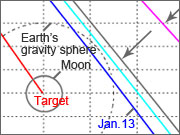 |
|---|
Nov. 19, 2009 Updated
HAYABUSA: Resumption of return cruise by combining two ion engines
|
On November 4, JAXA found that one of the main ion engines aboard the Asteroid Explorer “HAYABUSA” had autonomously stopped during the second propulsion period in its return cruise back to the Earth. As a result of studying the measures to cope with this situation, JAXA confirmed that we can gain thrust power that is equivalent to that of one engine by combining the neutralizer of the Thruster A and the ion source of the Thruster B. |
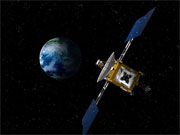 |
|---|
Nov. 9, 2009 Updated
Asteroid Explorer "HAYABUSA" Ion Engine Anomaly
|
On November 4 (Wed., Japan Standard Time), the Japan Aerospace Exploration Agency confirmed that one of the main ion engines (Thruster D) of?the Asteroid Explorer “HAYABUSA” had automatically stopped due to a voltage increase triggered by degradation of the neutralizer. The HAYABUSA was in the second orbit shifting phase aiming to return to the Earth in June 2010. Since we found the anomaly, we have been trying to recover the engine while investigating the thruster; however, we have not been able to reactivate the engine yet. |
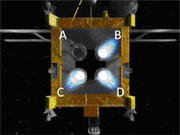 |
|---|
Mar. 3, 2009 Updated
14 new place names approved on ITOKAWA
|
The ITOKAWA asteroid that the HAYABUSA probed is a very small asteroid of about 500 meters, but it reveals a lot of features including large crags (boulders,) craters, and planes. The HAYABUSA project team named the geographical features and marks for the sake of their mission and research activities. Recently, 14 of them were approved by the International Astronomical Union (IAU.) |
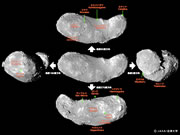 |
|---|
Feb. 4, 2009 Updated
HAYABUSA: Firing ion engine and starting second phase orbit maneuver to return to Earth
|
JAXA reignited the ion engine of the Asteroid Explore "HAYABUSA" for a powered flight at 11:35 a.m. on February 4, 2009 (JST.) The HAYABUSA arrived at the asteroid "ITOKAWA" in 2005 and is now scheduled to return to the Earth in June 2010.We will continue to gradually accelerate the HAYABUSA by the ion engine until around March 2010 to carry out the second phase orbit maneuvering for returning it to the Earth. |
 |
|---|
Jun. 2, 2008 Updated
Hayabusa reached the farthest deep space
Hayabusa stays at 2.5AU from Earth beyond Sun at the end of May 2008. When we see Hayabusa from Earth, it can be seen at the position of 12 degree apart from Sun. On the other hand Hayabusa should glance at Earth of 8 degree from Sun.
| <-1AU-> | <-- 1.5AU--> | |||
| Earth | ------------- | Sun | ------------------- | Hayabusa |
Due to such a long distance between Earth and Hayabusa the communication time lag reaches about 40 minutes. Hayabusa has kept its attitude in the spin stabilization without thrust by the ion engines since last October.
So, the Earth tracking center had caught intermittently the signal form Hayabusa on the particular occasion for the onboard antenna to point toward Earth in accordance with the spinning of 10-minute cycle. The small glancing angle between Sun and Earth from Hayabusa enables simultaneously both Earth pointing of the onboard antenna and Sun pointing of the solar array. As a result the continuous communication is established and will be kept by next March.
Hayabusa spacecraft in deep space restores its energy with low activity for Earth return. On the other hand the Hayabusa operation team on the ground has just started to prepare for the capsule retrieval.
Mar. 6, 2008 Updated
Hayabusa passed through the third aphelion of 1.63AU from Sun
|
Hayabusa asteroid explorer, under the ballistic flight in the spin attitude stabilization, passed through the third aphelion of 1.63AU from Sun on February 28, 2008. Hayabusa Operation Team
|
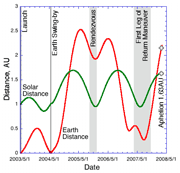 |
|---|
Oct. 29, 2007 Updated
Hayabusa Finished First Leg of Orbit Maneuver toward Earth
|
Hayabusa asteroid explorer had been executing the powered flight toward Earth using a single reaction wheel and the microwave discharge ion engines since April this year. The achievement of the first leg of orbit maneuver around the perihelion led Hayabusa into turning off them and shifting the spin mode from three-axis attitude stabilization on October 24, 2007 according to the plan. The ion engines generated 1,700 m/s delta-V with 31,000 hours in total accumulated operational time up to now and still keep good thrust performance and enough propellant. |
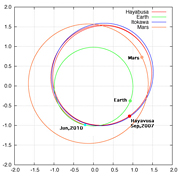 |
|---|
Aug. 20, 2007 Updated
Successful re-ignition of Ion Engine C onboard Hayabusa
Hayabusa spacecraft had been on the way to Earth with the ion engines B and/or D powered on since April 2007, though it lost the functions of chemical thrusters and two of three reaction wheels at the proximity operation around the asteroid. At the rescue operation in 2006 the ion engine C was not confirmed to exhaust the plasma jet. On July 28, 2007 a series of the restoration works and a new operation sequence revived the ion engine C again, which are accelerating Hayabusa on behalf of the engines B and D aiming for the Earth return on 2010. Sharing the delta-V duty among the multiple engines will secure a safety flight for the homeward journey.
Because the severe solar radiation seemed to increase the temperature beyond the safety zone to prevent the fuel leak, Hayabusa was operated with the attitude leaned against Sun so as to avoid solar heat flux in May. It passed through the perihelion at the solar distance 0.95AU on June 7 without any problems. During this term the engine D accelerated continuously Hayabusa as scheduled. At the end of July after establishment of the safety temperature, the warming up of a power supply by electrical heaters during several days and a special operational sequence successfully ignited plasmas again in the engine C. Then the Hayabusa's acceleration was shifted from the engine D to C reserving the rest of operational life.
The turn-on of the engine C is good news for the homeward journey of Hayabusa, which is still frighten at additional malfunctions. Since May 2003 each ion engine has been operated in space as follows
Engine A: stand-by
Engine B: about 9,500 hours
Engine C: about 7,000 hours
Engine D: about 13,500 hours
Total: 30,000 hours
Hayabusa will continue the powered flight using the engine C till November this year and then change to the ballistic flight with hibernation mode.
Apr. 25, 2007 Updated
Hayabusa leaves for Earth
|
Since February 2007, JAXA has been carefully preparing to start the fully fledged return trip to Earth using the ion engine and one attitude control reaction wheels (as two of the three wheels are unavailable due to anomalies.) The Hayabusa's return to the Earth is scheduled for June 2010. |
 |
|---|
Apr. 4, 2007 Updated
Hayabusa to start return trip to Earth in mid April
|
The asteroid explorer "Hayabusa" which landed on the asteroid "Itokawa" November 2005, delivered its probe container for acquired samples to the re-entry capsule, stored it in the capsule, then tightly shut the lid (with latches and seals.) |
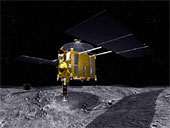 |
|---|
Jun. 2, 2006 Updated
"Science" magazine features results of "Hayabusa" observations
|
The asteroid probe "Hayabusa," which landed on the asteroid "Itokawa" last November, successfully turned on its ion engine, and it is now aiming to return to Earth in June 2010. The U.S. eminent scientific journal Science features the results of Hayabusa's scientific investigations in its June 2 edition. The "Hayabusa" observed Itokawa's shape, geographical features, reflectance, mineral composite, and gravity from an altitude of three to 20 km, and clarified the Itokawa's structure as a "pile of rubble." Science published seven Hayabusa-related essays, the first time for the magazine to feature a Japanese asteroid probe project. The Hayabusa project also received a "Space Pioneer Award" from the National Space Society of the United States at the International Space Development conference held in Los Angeles in May. |
 |
|---|
Nov. 12, 2005 Updated
MINERVA (micro-rover) released
|
We confirmed that MINERVA (micro-rover) released at 3:24 pm (Hayabusa onboard time). Detailed condition are still investigating. Hayabusa is now ascending to home position. (right) Itokawa's image captured at 1:40 pm JST. You can see the shadow of Hayabusa. |
 |
|---|
Oct. 26, 2005 Updated
Altitude Estimation using Navigation Camera
|
Hayabusa is equipped with a Light Detection and Ranging (laser altimeter) to measure the distance between an object and the satellite using a laser beam. In addition, we have considered another method to measure the relative position from the Itokawa using acquired images. |
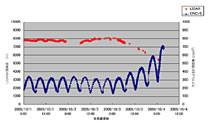 |
|---|
Oct. 25, 2005 Updated
The Current Status of the Near-Infrared Spectrometer (NIRS)
|
Hayabusa is equipped with the Near Infrared Spectrometer (NIRS) to inspect minerals on the surface of the asteroid. To date, the Hayabusa has carried out observations mainly around the equator of the Itokawa. |
 |
|---|
Oct. 17, 2005 Updated
Generating a shape model of the asteroid Itokawa using the Laser altimeter (LIDAR)
|
The shape of the Itokawa has been measured by the Light Detection and Ranging Sensor (LIDAR, or laser altimeter), part of the Hayabusa's onboard equipment. We can learn about the three-dimensional shape of the Itokawa through LIDAR observations. |
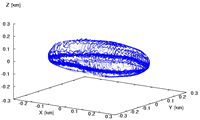 |
|---|
Oct. 12, 2005 Updated
Global Mapping of Itokawa (the initial global shape model)
|
Numerical Shape Modeling of Itokawa 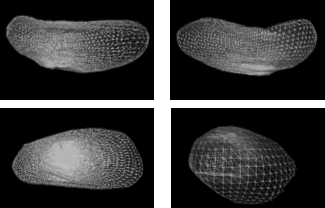 Figure 1 Initial Shape model
CG images based on the reconstructed model How to Reconstruct the Shape Model
 Figure 6 Process to Restrict the Possible Projected Volume |
Oct. 3, 2005 Updated
Imaging and position keeping at the Gate Position
|
-Exposures at Gate Position |
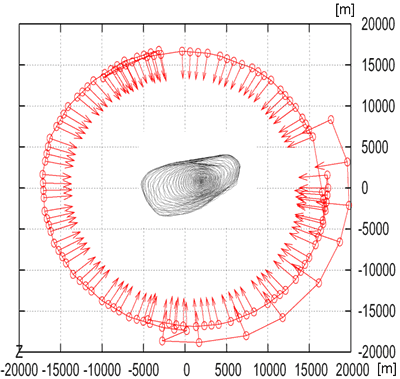 |
|---|
|
-Station Keeping and Pointing to Itokawa |
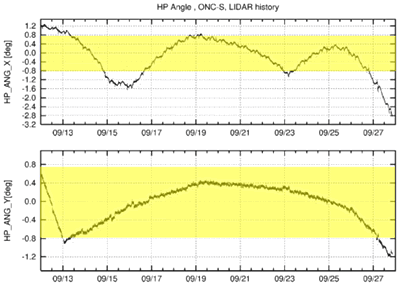 |
|---|
|
-Laser Altimeter and Image-based Pseudo Range |
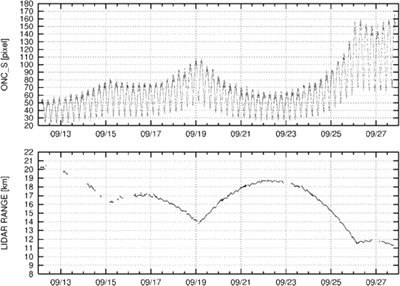 |
|---|
Sep. 22, 2005 Updated
Proposal of the names of representative terrain on Itokawa
|
The IAU guideline says that terrain larger than about 100 meters shall have the names of gods, internationally well known places with significance to be approved. Hayabusa project team proposes following names for the major features on Itokawa. Smaller terrain will be given names based on the nicknames referred to by the Joint Science Team analysts.
|
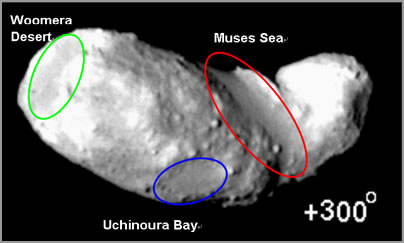 |
|---|
Sep. 12, 2005 Updated
Hayabusa arrives Itokawa
|
Hayabusa arrived Itokawa on 10:00 am, 12 Sep (JST: Japanese Standard Time). Now Hayabusa hovers around 20 kilometers away from asteroid Itokawa.  |
 |
|---|
Sep. 11, 2005 Updated
Itokawa Image on September 10
|
Hayabusa continues approaching Itokawa, and its image is growing day by day. The left image is taken at 15:00 UTC on September 10 by the visible imager, AMICA. The distance from Hayabusa to Itokawa is approximately 30 km. The right image was obtained at 16:42 UTC on the day. The left image shows different face from the last release. Itokawa rotates about 50 degrees between left and right images. Surface features are more clearly seen. 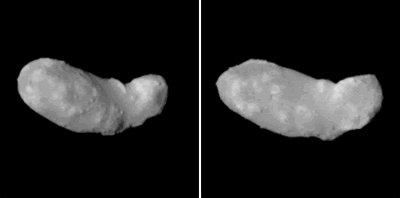 Images of Itokawa: Sept. 10 (1 deg. x 1 deg.) Left: 15:00 UTC Right: 16:42 UTC |
Sep. 10, 2005 Updated
Itokawa Image on September 9
|
Hayabusa continues approaching Itokawa, and its image is growing day by day. The left image is taken at 16:28 UTC on September 9 by the visible imager, AMICA. The distance from Hayabusa to Itokawa is approximately 70 km. The right image was obtained at 18:11 UTC on the day. Itokawa rotates about 50 degrees between left and right images, and the irregular shape of Itokawa is clearly seen. Some features such as craters are also seen in these images.   Images of Itokawa: Sept. 9 (25 arc-min x 25 arc-min) Left: 16:28 UTC Right: 18:11 UTC |
Sep. 9, 2005 Updated
Itokawa Image on September 7
|
Hayabusa continues approaching Itokawa and the image of it has grown day by day.  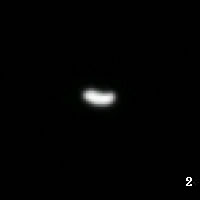 Itokawa : 9/4 02:36 UTC (1), 9/6 03:32 UTC (2). (25 x 25 arc-minutes) 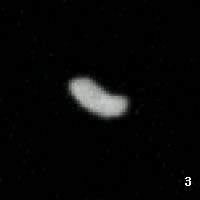 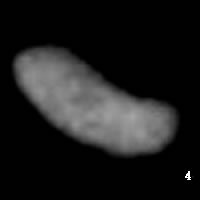 Image of Itokawa : Sept. 7, 16:00 (3: raw, 25 arc-min x 25 arc-min) (4: processed) The image 3 is what Hayabusa took for Itokawa at 16:00 UTC on September 7 by the Visible Imager, AMICA. The v-band (540nm) filter was used with a horizontal polarizer. Sun light illuminates Itokawa from a little left. |
Sep. 7, 2005 Updated
Hayabusa detects Itokawa's rotation
|
This animated image is built from the twenty images taken between 18:10, 5 Sep and 0:30, 6 Sep (JST). |
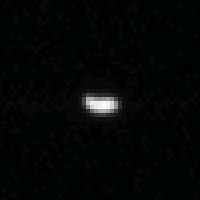 |
|---|
Sep. 5, 2005 Updated
Hayabusa successfully captured Itokawa shape for the first time in space.
|
As of September 4th morning of 2005, Hayabusa is at approximately 1,000 km toward Earth with respect to Itokawa, a near Earth asteroid target of the spacecraft, with the approach speed of 10 km per hour. Hayabusa took a series of its Optical Navigation Camera aboard on the day and the photos revealed, for the first time in space, the shape information of Itokawa. Left one was taken when the brightness was at the top, while the right one was at the bottom. The upward direction here is almost identical to the north of the ecliptic frame. 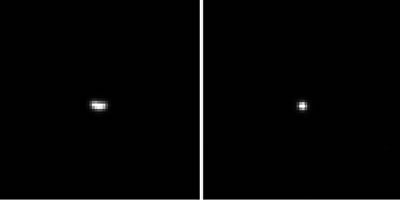 [Itokawa Images : 9/4 02:36 UTC (left), 9/4 05:12 UTC (right). (25 arc-minutes x 25 arc-minutes)] The light curve plot below corresponds to the images above. The images that should be were estimated numerically and those well agree with one another. Note that the following model illustrates the shape model obtained based on the ground-based observations including radar measurement performed last year. (Courtesy JPL/NASA) 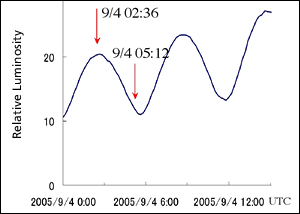 [Relative Brightness of Itokawa] 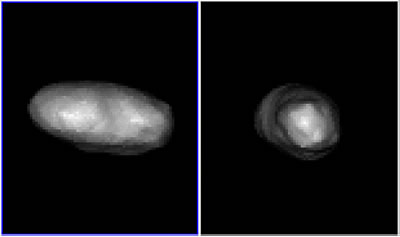 [Itokawa Shape predicted for Sept. 4th Imagery. Ref.Ostro, S.]
|
Sep. 1, 2005 Updated
1,900 km to the Itokawa
|
JAXA cut off the ion engine of the Hayabusa on August 28, and shifted its flight mode to approaching the Itokawa over its ecliptic. At the end of operations on September 1, the distance to the Itokawa was 1,900 km and Hayabusa was moving toward it at a velocity of 18 km per hour. The photo is an image of the Itokawa taken by the onboard optical navigation camera (ONC-T) of the Hayabusa. |
 |
|---|
Aug. 26, 2005 Updated
Hayabusa's navigation camera photographed the "Itokawa"
|
The asteroid explorer "Hayabusa" is flying smoothly toward the asteroid "Itokawa" and is expected to arrive in mid September. |
Nov. 16, 2004 Updated
Welcome to Japan!
The first Hayabusa International Symposium
|
The first Hayabusa International Symposium was held between October 20 and 22 and invited researchers from many countries including the US, Australia, Italy, and France. |
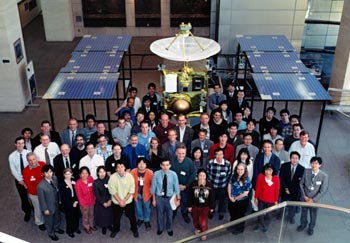 A commemorative photo in front of the life-sized Hayabusa model. Some 100 researchers got together from Japan and overseas. |
|---|
May 20, 2004 Updated
The close shot of area surrounding Japan by Hayabusa just before it came closest to the Earth
|
The image was taken when Hayabusa flew over Japan just before it came closet to the Earth for its swing-by. It was taken at around 1:00 p.m. on May 19, and the distance to the Earth was about 60,000km. (This is the last frame of the animation published yesterday.) |
Earth images taken by Hayabusa after its Earth swing-by
|
These are images acquired by Hayabusa as it was going away from the Earth after its Earth swing-by. They were pictured by the onboard wide angle camera (ONC-W2). |
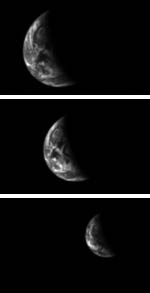 |
|---|
May 19, 2004 Updated
Animation showing area around Japan taken by onboard camera of Hayabusa
|
This is an animation compiled by images of the area around Japan acquired by the onboard Asteroid Multiband Imaging Camera (AMICA). The camera has multiple color filters, but only one filter was used for the sequence shots, thus images are in black and white. |
The Earth taken by the optical navigation camera (a wide angle camera) (Animation)Hayabusa is equipped with two kinds of cameras, a telephoto type and a wide angle type. Previously acquired images were all taken by the telephoto camera, but the wide angle one also took some shots of the Earth this time. Seven sequence photographs were converted into an animation. |
The earth pictured by HayabusaThis earth image was acquired by Hayabusa at 10:00 p.m. on May 18 (Japan Standard Time). The distancebetween Hayabusa and the earth at that time was about 295,000 km. As Hayabusa came closer to the earth, the image became much clearer than the one taken on May 17. It shows the Atlantic Ocean in the center. |
May 18, 2004 Updated
Hayabusa acquired images of the earth and the moon.
Hayabusa, which is coming closer to the earth for a swing-by, successfully acquired images of the earth and the moon on the 16th and the 17th.
Earth image taken by HayabusaThis earth image was acquired at 3:30 a.m. on May 17 (Japan Standard Time, JST). The distance between Hayabusa and the earth at that time was about 910,000 km. The image shows the south part of the North American Continent (Texas area) in the center, and you can also see the whole continent, the Pacific Ocean and the Atlantic Ocean in blue, and clouds over them. |
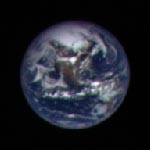 |
|---|
Moon image by Hayabusa (1)This moon image was acquired at 8:30 p.m. on May 16 (JST). The distance between the moon and Hayabusa at that time was about 710,000 km. |
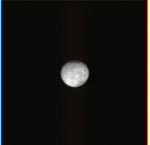 |
|---|
Moon image by Hayabusa (2)This moon image was acquired at 8:00 p.m. on May 17 (JST), about a day after the above image (1) had been taken. The distance between Hayabusa and the moon at that time was about 340,000 km. |
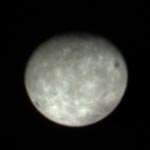 |
|---|
May 10, 2004 Updated
Hayabusa (Earth Swing-by)
|
The following are related sites for the Earth swing-by and the Hayabusa.
|
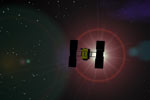 |
|---|
Apr. 16, 2004 Updated
The rough shape of asteroid "ITOKAWA" was elucidated.
|
A recent radar observation clarified the rough shape of an asteroid called "ITOKAWA", where the MUSES-C (Hayabusa) is heading for. (Above photo) |
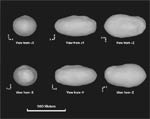 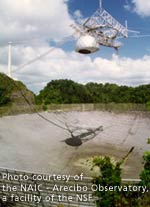 |
|---|
Jan. 30, 2004 Updated
Hayabusa is flying smoothly
|
JAXA finished the running test of an ion engine, "µ10", which is the same type of the onboard engines of Hayabusa. The running hours reached 20,614 hours (or about 859 days), and that is about 7 times longer than that of one onboard engine of Hayabusa, or 1.3 times of the total operation hours expected for a mission. We will acquire data by analyzing the tested engine in details for ion engine development for future flights. |
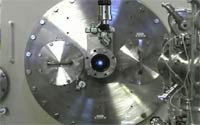 |
|---|
Nov. 6, 2003 Updated
Hayabusa is flying smoothly
|
The onboard ion engines of the Hayabusa are operating smoothly as the main propulsion system to travel among planets. To date, the total operation time of the three sets of ion engines has reached about 6,000 hours (2,000 hours per engine). The Hayabusa is currently flying about 7.2 million km away from the Earth in the same direction as the Earth's revolution. The Hayabusa is scheduled to gain more speed by "swinging by" the Earth in May 2004, and arrive at an asteroid called "ITOKAWA" in the summer of 2005. |
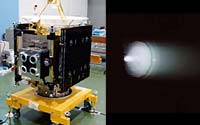 |
|---|


